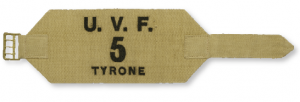‘For God and Ulster’: accoutrements of the UVF
Published in 18th–19th - Century History, Artefacts, Home Rule, Issue 5 (September/October 2013), Volume 21 The Ulster Volunteer Force (1913–20) was a paramilitary organisation created in January 1913 in response to the campaign against Home Rule. The UVF soon had 90,000 members; it was mainly led by retired British Army officers and trained by reserve non-commissioned officers. The members were well equipped compared to their southern opponents, the Irish Volunteers; many had uniforms based on British Army patterns, while others wore UVF armbands and bandoliers. The UVF accepted men aged 17–65 who had signed the Ulster Covenant; in the beginning territorial battalions were established in the counties of Ulster, with twenty battalions in Belfast.
The Ulster Volunteer Force (1913–20) was a paramilitary organisation created in January 1913 in response to the campaign against Home Rule. The UVF soon had 90,000 members; it was mainly led by retired British Army officers and trained by reserve non-commissioned officers. The members were well equipped compared to their southern opponents, the Irish Volunteers; many had uniforms based on British Army patterns, while others wore UVF armbands and bandoliers. The UVF accepted men aged 17–65 who had signed the Ulster Covenant; in the beginning territorial battalions were established in the counties of Ulster, with twenty battalions in Belfast.
An Ulster Volunteer Force armband for Tyrone and an Ulster Volunteer Force dirk inscribed ‘For God and Ulster’.
On 15 April 1914 the UVF successfully landed 25,000 German, Austrian and Italian rifles and three million rounds of ammunition at Larne, Co. Antrim, from the Clyde Valley, providing weapons for many of the new recruits. This was a substantial and well-planned secret operation organised by Major Frederick Crawford that allowed a quarter of the UVF members to be armed. Nationalists charged that the British government had allowed the importation of the weapons to give the UVF a head start. In comparison to the Larne landings, the Irish Volunteers, created in November 1913, only imported one large shipment of 1,500 rifles on 26 July 1914 on the Asgard. In addition, the police responded differently to the Asgard landings by attempting to capture the rifles, and this eventually led to the Bachelor’s Walk massacre, when four civilians were shot by a Scottish regiment of the British Army.

An Italian Vetterli-Vitali MI888 rifle with a UVF stamp on the butt (to the right of the brass plaque, left). It had the disadvantage of firing a rare 10.4mm-calibre bullet, which meant that there was never sufficient ammunition for them.
(All images: National Museum of Ireland)
While some of the UVF rifles were modern, such as the Austrian-made Mannlicher, many were antique Vetterli-Vitali rifles. This four-round repeating rifle was invented in Switzerland in 1867 and was used by the Italian Army from 1887 to 1896. The rifle also had the disadvantage of firing a rare type of bullet, of 10.4mm calibre, which meant that there was never sufficient ammunition for them.
 With the outbreak of the First World War both paramilitary bodies joined the British Army, making a substantial contribution to the war effort during hostilities, in particular in the three Irish divisions, 10th, 16th and 36th (Ulster Division). HI
With the outbreak of the First World War both paramilitary bodies joined the British Army, making a substantial contribution to the war effort during hostilities, in particular in the three Irish divisions, 10th, 16th and 36th (Ulster Division). HI
Lar Joye is curator of military history at the National Museum of Ireland (Decorative Arts).
















